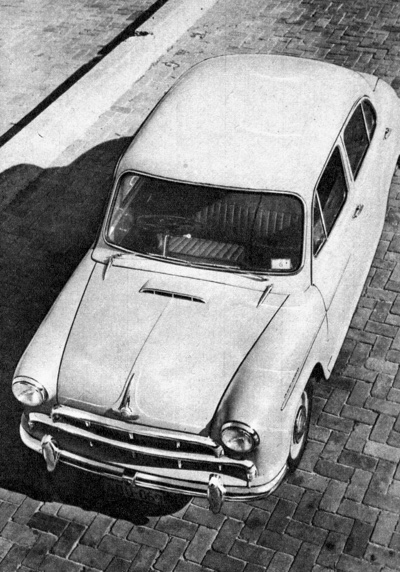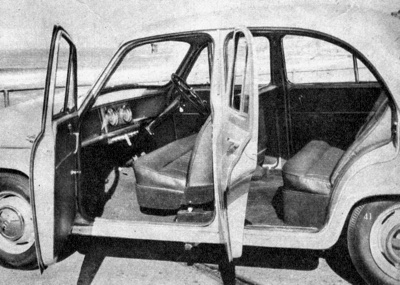Morris Oxford Series 2
Reviewed by Unique Cars and Parts
Our Rating: 3
Introduction
Following in the footsteps of the original and very successful Morris Oxford Series I, or MO, the fully redesigned Oxford was announced in May
1954, and following the formation of BMC, notably received the Austin-designed B-Series OHV straight-4. This modern 1.5 litre (1489cc / 90 in3)
engine produced a respectable 50 hp (37 kW) and allowed the Oxford to reach 74 mph (119 km/h).
Hydraulic drum brakes all round were still used but increased to 9-inch (230 mm) diameter.
Steering was still of the beautifully light and precise
rack and pinion type. Styling was entirely new though the rounded body maintained a family resemblance to the
Morris Minor.
The Morris Oxford Traveller
As was the case with the previous version, a pair of four-seat configurations, 4-door saloon and 2-door Traveller were offered. The column gear change and front bench seat allowed the saloon to be advertised as a full six-seater. The handbrake lever was located between the side of the seat and the driver's side door. Unusually for a British car of its class at the time, the heater was a standard fitting but the radio remained an extra.
Sales remained strong when the Series III arrived in
1956. The British Motor magazine tested a Series II saloon in
1954 recording a top speed of 74.2 mph (119.4 km/h) and acceleration from 0–60 mph (97 km/h) in 28.9 seconds and a fuel consumption of 28.2 miles per imperial gallon (10.0 L/100 km; 23.5 mpg‑US). The test car cost UK£744 including taxes.
A 2.6-litre six-cylinder 7-inches longer Morris Isis version was announced 12 July
1955 with a saloon or Traveller estate body: the rear half of the Traveller body used the same timber-frame ("half-timbered") construction as that used for the better remembered Morris Minor Traveller.
Hindustan Motors of India produced the four-cylinder version of this car (except the air-vent situated upon the bonnet) naming it “Hindustan Landmaster”.
Not So Stodgy
Those that thought of the Morris Oxford as a somewhat stodgy family saloon, built for utilitarian travel rather than speed and style, sure got a shock when the entirely new Series II model was released in 1954. Quiet and smooth in operation, its overhead valve engine was surprisingly lively. The car had a top speed about ten m.p.h. greater than the previous model Oxford, coupled with faster acceleration at the top end of performance, and displayed a new tenacity on hills. The functionally designed body is extremely roomy inside; this is particularly noticeable in the front compartment, where spaciousness has been enhanced by curving the full-width parcels shelf in line with the windscreen. The latter, together with generous side-windows, gives ample vision all round. The instrument panel was one of the neatest and most effective then available on a reasonably priced car.. General finish of the car was well above the average - particularly the high-gloss duco. Whether you are pottering around the city or cruising at speed, the car's handling qualities inspired confidence, and its general stability was enhanced by good and accurate steering.

Morris Oxford Series 2

Morris Oxford Series 2 Interior
|
Morris Oxford Series 2 On The Road
One of the first things owners noticed when setting out on a drive behind the wheel of the Morris Oxford Series II was the comfortable driving position. Be it in the city or out doing some country touring, with the speedo rarely dropped below 50 or 60 m.p.h. There was little road noise ófar less than with the previous Oxford. Of course these days the handling would leave an awful lot to be desired, but judged against its competition of the era, the Oxford's road manners were beyond criticism for a family saloon. Body roll and tyre squeal were scarcely noticeable, but there was a tendency towards a slight drift when taking bends at maximum speed. Slip from either the front or rear was not excessive. Only when the car was thrown into sharp corners brutally would the rear wheels break away, and this was far from alarming; with the car's accurate steering, an increase in engine power made correction a pleasure rather than hard work.
For the Series II, the Oxfords front
suspension was redesigned, featuring rubber-bushed top links of wishbone type and telescopic shock absorbers mounted on the lower suspension arms. Although rather firm, the system gave a pleasant ride and was free from front-end sag when cornering. Potholed and corrugated surfaces were absorbed in a commendable manner, and the suspension units were quiet in operation and difficult to bottom. Road testers and owners alike found the Oxford Series 2 had excellent road manners and - most importantly - a large margin of safety for the not-so-experienced driver.
Steering and Brakes
Light and completely accurate, the excellent
rack-and-pinion steering needed only 2 and a half turns of the steering wheel from lock to lock. A line could be held on any corner effortlessly, with a tendency to
understeer. Road shock, which was normally-inherent in this type of steering, had been greatly reduced by double dam ping. The rather upright rake of the steering column was quite comfortable for long journeys. Floor controls were well spaced but a little too long, and little resting space was available for the left foot when it was not on the clutch. The Lockheed
hydraulic drum brakes had greater staying power than those cn the previous model; only when they were used harshly on a long descent is there any sign of fade. The front brakes were of two-leading-shoe design, and sudden halts would not provoke nose-diving or a pull to one side. However, some drivers found the pedal thrust too long and rather straight on the floor, although the pressure was reasonably light.
Ahead of its time was the fitting of a full-lever-type handbrake on the floor beside the driver's right hand - think
HQ Holden style; it proved most efficient in action, well out of the way, rugged in design, and far in advance of the types that are found under the facia - a placement that lasted for another couple of decades! As mentioned in the introduction, the most notable "change on the "new Oxford" was the 1.2-litre o.h.v. engine, which produced 50 b.h.p., or 9 b.h.p. more than the previous side-valve job. The unit was smooth, flexible, and extremely quiet, and could be cruised effortlessly at 55 to 60 m.p.h. Rarely would a road tested, when giving the car a bit of a thrash on the test circuit, find that the engine exhibited any kind of stress. Sustained use of third gear at 45 to 50 m.p.h. on long climbs failed to raise engine temperature above normal. Engine accessibility for major or minor maintenance tasks was excellent. Placing the S.U. fuel pump in the boot made this unit completely inaudible.
Gear ratios had been well chosen, arid use of the gears assisted in a lively getaway. The box was fairly quiet in operation, and the
synchromesh was difficult to over-ride even when used harshly. Some owners complained that the length of travel in the lever was excessive, requiring the driver to-lean forward to select third gear; and reverse was a little woolly to locate. If they were complaining, we can only assume this was indeed a problem when judged against its contemporaries, but it was hardly a glaring fault. In all other aspects, the selection of gears, whether the lever was used heavily or lightly, was positive. Pressure on the clutch was fairly light, although pedal thrust was a trifle too long.
The Oxford Series 2 body was of pleasing design, without any excess of glitter and trimmings. There was a Detroit flavor in the bonnet air-intake, which at the same time was above average in efficiency and supplied air to the heater-demister unit that was fitted as standard equipment. In the tastefully furnished interior the bench-type seats were generous in size and finished in real leather; but it seemed a pity that an arm-rest was not fitted for the driver. Compact and attractive, the facia employed two large cluster dials, low and well in front of the driver, which could be read at a glance. The instruments consisted of a
speedometer with trip and total-mileage recorders, an electric clock, an
ammeter, and
fuel,
oil, and
water-temperature gauges. Various switches were set in a neat line under the instruments; the controls for the heater-demister unit were under the facia.
The extended boot offered plenty of luggage space and was given extra depth by fitting the petrol tank forward against the back scat. The spare wheel was housed out of the way on the right side. All in all then, the Oxford Series II was excellent value for money and a capable performer. Well built and able to handle 2nd grade roads, it offered lively performance and was far above the average in both interior and exterior finish. It
handled extremely well and was a safe car to drive.



